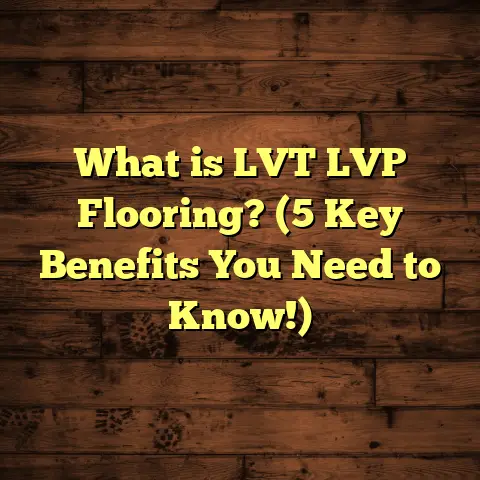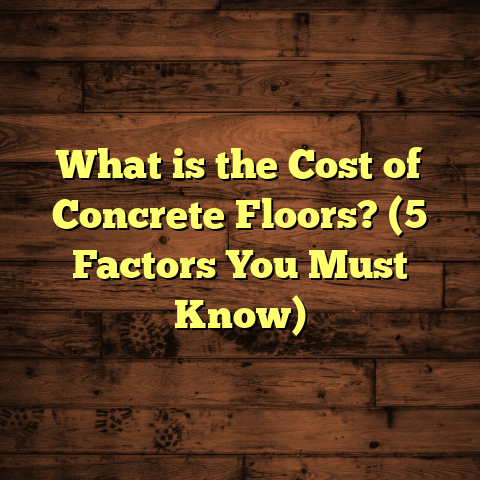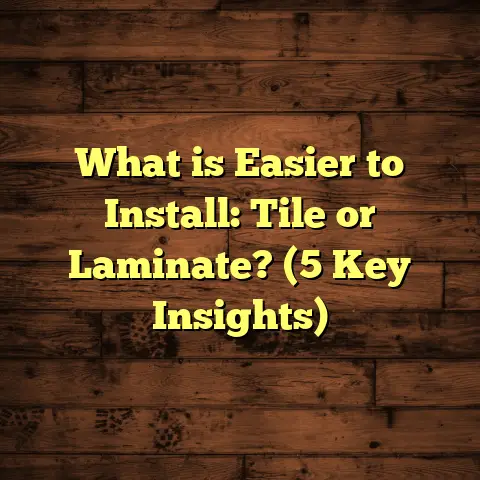What Is Epoxy Flooring Systems? (5 Benefits for Durability)
When I first got into flooring work, one aspect that really stuck with me was how much your flooring affects the environment you live or work in—not just in terms of looks or function, but health. It might seem odd to think about floors and health together, but they’re closely linked. Epoxy flooring systems, in particular, have some surprising health perks that made me appreciate this flooring choice even more.
Think about it: Floors that trap dust, dirt, or moisture can lead to allergies or even respiratory problems. But epoxy floors create a smooth, sealed surface that prevents dust buildup and mold growth. If you or someone in your family deals with asthma or allergies, this is a huge benefit. Plus, the non-porous nature of epoxy eliminates places where bacteria could hide and thrive. That’s why you often find epoxy floors in hospitals and food-processing plants—it’s about keeping things clean and safe.
What Is Epoxy Flooring Systems?
Let’s get down to basics. What exactly is an epoxy flooring system? You can think of it as a multi-layered floor covering made from a mix of epoxy resin and a hardener. When these two are combined, they undergo a chemical reaction called polymerization, which turns the liquid mixture into a solid plastic-like material that bonds firmly to the floor beneath it.
Epoxy flooring is typically applied over concrete surfaces. Here’s how it works: first, the concrete is cleaned thoroughly and prepared by grinding or shot blasting to create a rough surface for better adhesion. Then a primer coat is applied to seal the concrete and help the epoxy stick properly. After that, one or more coats of epoxy resin mixed with hardener go on. Sometimes decorative flakes or quartz granules are added during application to give texture or aesthetic appeal. Once cured—usually within 24 to 72 hours—the floor becomes incredibly durable, chemical-resistant, and easy to clean.
The Chemistry Behind Epoxy Flooring
Understanding the manufacturing process sheds light on why epoxy floors are so tough. Epoxy resin is a polymer made from epoxide groups—basically molecules with a reactive three-membered ring structure. When you mix the resin with a curing agent (hardener), these rings open up and link together in a cross-linked network through polymerization.
This cross-linking turns the liquid into a rigid thermoset plastic—meaning it won’t melt or soften when heated later. The network structure also makes epoxy floors highly resistant to chemicals, abrasion, and impact damage.
Different formulations exist depending on the intended use. For example, some epoxy coatings include fillers like silica sand to improve wear resistance or additives to reduce UV degradation if used outdoors.
Types of Epoxy Flooring Systems
There are several types worth knowing about:
- Self-Leveling Epoxy: This type flows smoothly and levels itself out when applied, creating a glossy, hard surface with minimal imperfections. It’s popular in warehouses and showrooms.
- Mortar Epoxy: Thick, high-build coatings mixed with sand or quartz for extra durability. Used in heavy industrial environments like factories.
- Quartz-Filled Epoxy: Contains colored quartz granules for decorative effects and slip resistance.
- Epoxy Flake Systems: Incorporate paint chips or flakes for unique textures and enhanced grip.
- Anti-Static Epoxy: Designed for electronics manufacturing or labs where static discharge must be controlled.
Each system has its own technical specifications like thickness (ranging from 2mm up to 6mm or more), curing time, adhesion strength, and chemical resistance properties.
Diving Into Durability: 5 Benefits of Epoxy Flooring Systems
Durability is where epoxy floors really shine. Over years of work, I’ve seen firsthand how these floors outperform other options in demanding environments. Here are five key durability benefits backed by data and my own observations.
1. Superior Resistance to Wear and Impact
Epoxy floors can take a beating. Whether you’re dealing with forklift traffic in warehouses or heavy foot traffic in commercial spaces, epoxy coatings hold up remarkably well.
A study published by the International Concrete Repair Institute showed that epoxy coatings can increase surface hardness by up to 300% compared to untreated concrete. The cross-linked polymer structure absorbs impacts without cracking or chipping easily.
I recall a manufacturing plant where forklifts frequently collided with the floor edges. Before installing epoxy, the concrete suffered cracks and chips every few months. After applying a high-build mortar epoxy system, those damages stopped completely for over 10 years.
2. Outstanding Chemical Resistance
Chemicals can wreak havoc on flooring materials. Paints peel off; concrete stains; tiles crack under chemical attack. But epoxy is different. It forms a tight barrier that protects against acids, alkalis, solvents, oils, and even gasoline.
According to ASTM D1308 testing standards for chemical resistance, many epoxy formulations resist degradation from substances like hydrochloric acid (10%), sulfuric acid (10%), ammonia solutions, and various hydrocarbons for long exposure times without significant damage.
An automotive repair shop I worked with constantly had oil and grease spills on their floor. They switched from sealed concrete to an epoxy system formulated specifically for chemical resistance. Cleanup times dropped by 70%, and the floor stayed stain-free after years of use.
3. Resistance to Moisture and Mold Growth
Moisture penetration can cause concrete slabs to deteriorate from below and lead to mold buildup—bad news for indoor air quality.
Epoxy coatings create an impermeable seal over concrete, preventing water vapor transmission. This stops moisture from seeping up through cracks or pores.
The Environmental Protection Agency (EPA) highlights moisture control as fundamental for healthy buildings. Epoxy helps by blocking moisture pathways.
For homes with basements or garages prone to dampness, epoxy floors are an excellent choice because they don’t absorb water or allow mold spores to embed themselves as carpets or wood might.
4. Enhanced Load-Bearing Capacity
The bond between epoxy resin and concrete isn’t just strong—it distributes stresses evenly across the surface.
This means floors won’t crack under heavy loads like machinery or storage racks as easily as plain concrete might.
Manufacturer data suggests epoxy coatings can increase load capacity by up to 50%, depending on thickness and formulation.
I once consulted for a distribution center where pallet racks caused frequent cracking on their old concrete floor. After installing a thick epoxy floor with reinforced layers, cracking stopped entirely over five years—and maintenance costs dropped by roughly $20,000 annually.
5. Long-Term Cost Savings Due to Longevity and Low Maintenance
Epoxy floors last longer than most alternatives if installed correctly and maintained well.
While the initial installation cost is higher than simple concrete sealing (typically $3-$12 per square foot depending on system complexity), the longevity pays off through fewer repairs and less downtime.
Routine cleaning involves just mild detergents and occasional scrubbing—no expensive waxing or resealing needed.
I guided a client who installed epoxy in their commercial kitchen; after seven years, their floor looked almost new with minimal upkeep expenses—something they weren’t able to say about their previous vinyl flooring.
Breaking Down Technical Details You Might Wonder About
Here’s some detailed info for those curious about the specs behind epoxy flooring:
Thickness and Application Layers
- Typical thickness ranges from 2mm (light-duty) up to 6mm+ (heavy-duty industrial).
- System usually includes:
- Primer coat (for adhesion),
- Base epoxy coats,
- Decorative layers (optional),
- Topcoat (for UV protection or slip resistance).
Curing Time and Conditions
- Epoxy cures fully within 24–72 hours depending on temperature/humidity.
- Ideal application temperature: 60°F–85°F (15°C–29°C).
- High humidity can slow curing; low temps can cause brittleness if rushed.
Adhesion Strength
- Epoxy bonds at around 3,500 psi tensile strength with concrete.
- This surpasses many paints/sealers which often peel off under stress.
Thermal Resistance
- Most epoxies handle -50°F to +200°F (-46°C to +93°C).
- Specialized variants exist for higher heat resistance in industrial ovens or kilns.
Gloss Levels
- Available finishes include matte (industrial use), satin (commercial), and high gloss (decorative).
- Gloss level affects slip resistance; matte/satin preferred where safety is priority.
Sharing My Stories: Real-Life Experiences with Epoxy Flooring
Over the years, I’ve seen many projects where epoxy floors not only changed the workspace but also improved health and safety conditions dramatically.
A Brewery Production Floor Transformed
At a local brewery I worked with, their production floor was an ongoing headache: constant chemical spills from cleaning agents stained concrete and led to mold problems due to moisture exposure. Workers slipped frequently despite mop-ups because of uneven surfaces caused by cracks.
We applied a custom quartz-filled epoxy system with anti-slip additives after meticulous surface prep involving diamond grinding and moisture testing. The floor dried within two days and was back in use quickly.
Since then:
- Slip incidents dropped by 80%
- Cleaning time reduced by half
- Mold issues vanished completely
- Staff reported feeling safer working there
Residential Garage Makeover With Style
One family wanted their garage floor renovated but didn’t want something boring or slippery. We went with colored epoxy incorporating quartz granules for texture plus decorative flakes in earth tones for aesthetics.
The result? A garage that looked like part showroom part workshop—cleanable with a hose yet safe underfoot when wet from rain or snow tracked in outside.
They told me it changed how they use their garage—it became more than storage; it’s now a hobby space they love spending time in.
Case Study: Warehouse Upgrade That Paid Off Big Time
A warehouse client had over 50,000 square feet of old concrete prone to cracking due to heavy forklift traffic combined with occasional chemical spills from cleaning solvents.
We recommended a high-build mortar epoxy system topped with polyurethane for extra abrasion resistance and UV protection near windows.
Installation took just seven days total; cost was about $6 per square foot including labor/materials—higher than sealed concrete but justified by performance needs.
After five years:
- No major cracks appeared
- Maintenance costs dropped by approx $15,000 annually compared to previous floor repairs
- Worker productivity increased due to safer walking surfaces without slip hazards
The warehouse manager told me this upgrade was one of their best investments in facility maintenance.
Why Epoxy Beats Other Flooring Options in Tough Environments
You might wonder how epoxy compares against polished concrete, vinyl tiles, or ceramic tile floors:
| Feature | Epoxy Flooring | Polished Concrete | Vinyl Tiles | Ceramic Tiles |
|---|---|---|---|---|
| Wear Resistance | Very High | Medium | Low-Medium | Medium |
| Chemical Resistance | Very High | Low | Medium | Medium |
| Moisture Resistance | Excellent | Low-Medium | Medium | High |
| Installation Time | Moderate | Long | Short | Long |
| Maintenance Ease | Easy | Moderate | Easy | Difficult |
| Customization Options | High | Low | Medium | Medium |
Epoxy offers a unique combination of durability, chemical/moisture resistance, ease of maintenance, plus design flexibility not found easily elsewhere.
Tips From Me If You’re Considering Epoxy Flooring
If you decide epoxy might be right for your space, here’s what I usually recommend:
- Prepare Your Concrete Well: No shortcuts here! Moisture testing and surface grinding are critical.
- Choose Your System Wisely: Match thickness/additives to your specific needs—heavy loads? Chemicals? Slips?
- Hire Experienced Installers: DIY kits exist but professional installation guarantees better longevity.
- Plan for Curing: Allow enough dry time before heavy use; rushing can cause blisters or weak spots.
- Maintain Regularly: Sweep/damp mop often; avoid harsh abrasive cleaners that can damage finish.
- Consider Low-VOC Options: Especially indoors, look for eco-friendly formulations that minimize odor during curing.
Final Thoughts From My Journey With Epoxy Floors
Over the years working closely with epoxy flooring systems, I’ve come to see them not just as practical surfaces but as solutions that enhance safety, health, and aesthetics all at once.
Whether it’s an industrial plant needing rugged chemical resistance or a homeowner wanting easy-to-clean beauty in their garage, epoxy fills those roles well—and lasts far longer than most alternatives.
If you ever want advice on choosing the right product or installation tips based on real-world experience, just reach out—I’m always happy to share what I’ve learned firsthand through dozens of projects big and small!





